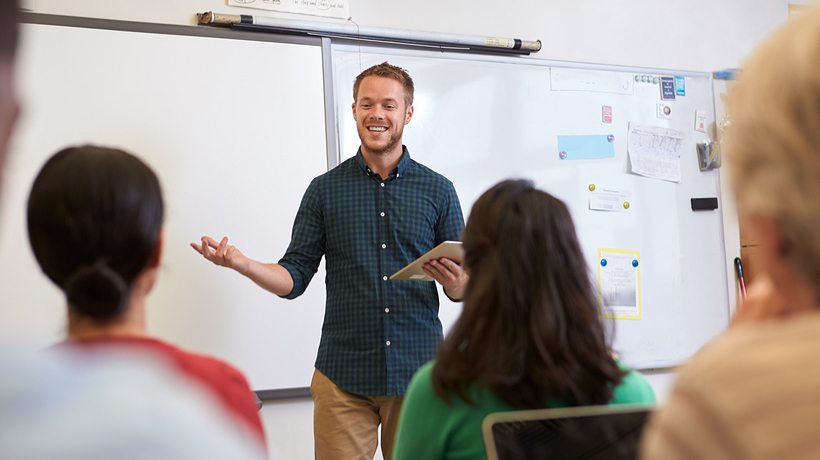The Key Roles Of An Educator In The Blended Classroom
The classrooms are changing every day and evolving with new eLearning methods, tools, and techniques. The conventional teacher-centric classrooms are giving way to more flexible, adaptive, and personalized learning spaces that will enable teachers to cater to a diverse spectrum of learners all at once through a blend of face-to-face and online strategies. In this shift it is very essentially for teachers to be quickly appraised of how they need to change their roles to fully leverage the benefits of the newer teaching setting. There is a need for teachers to adopt the blended learning practice while fully understanding the new roles that teachers have to take-on in a blended classroom. And the new role is much bigger than that of curriculum deliverer and conventional grader.
The blended environment calls for teachers to proactively develop and deliver standard-aligned content while tracking students’ learning paths and monitoring content engagement metrics as well as leveraging this actionable data and proven teaching practices to fulfill goals of personalized learning for every individual learner. Here are 5 key roles that the teachers will have to be prepared for before teaching in a blended classroom:
1. Classroom Planners
The blended classroom requires a teacher to opt for long-term planning of curriculum and instructions in advance. Teachers cannot plan over shorter immediate stints such as doing weekly lesson plans. Curriculum planning as well as instructional strategies must be figured in advance even before the session starts. The curriculum design must feature essential built-in resources for accommodating differentiated instructional strategies as well as assistive elements, rather than changing the design later when such a user may opt for a course. This initial planning will free up time for teachers to focus on data analysis and personalize the course for real-time adaptive adjustments based on students’ learning path. For this it is essential for blended classroom teachers to be familiar with a variety of instructional strategies, edTech tools, skills, and context to develop the right format of content.
2. Classroom Managers
In a blended classroom all students will be working differently, on a different content, on different tasks, at a different pace, in different groups. The learners are expected to self-monitor their progress; however, it is also important for the instructor to assume the larger role of a manager and setting appropriate leads to ultimately qualify all learners for the same learning goals. The instructor manager will need to set appropriate learning norms, learning-checkpoints, as well as engage all learners with differentiated tactics. The teacher-managers will have to keep a tab on each student’s learning path simultaneously as well as actively assisting each of them wherever they are struck.
There is a need for teachers to shift from teacher-centric classroom style towards the role of a manager who can effectively manage independent variable learners, delivering quality instructions across all learners as well as proactively troubleshooting their hindrances. The teacher-managers will also have to collaborate with each other across institutions for continuous professional development and experience exchange through teamwork.
3. Data Analytics
Teachers in a blended learning setting are expected to collect data upon students' performance as well as metrics to analyze content engagement which can be leveraged for real-time as well as long-term betterment of their course. With the integration data analytics tools in Learning Management Systems and big data analytics tools in blended classrooms, teachers can easily leverage classroom data to offer truly adaptive and personalized learning in a blended classroom. Teachers will be able to proactively analyze students’ performance, keep track of students’ learning pace, as well as monitor individually for each students where they stumble. This data will also expose gaps in the content and curriculum planning which will be used for improving student engagement by the next semester.
4. Risk Loving
The traditional standard-based curriculum has stifled the risk-loving teachers by tying students’ performance with their pay. Most teachers have taken to the road-most treaded and have been resistant to try novel approaches when it comes to content, instructions, or assessments. The blended learning setting provides the perfect outlet for teachers to explore risk-taking and in fact risk-taking teachers with higher engagement statistics, fulfilled learning outcomes, as well as greater referrals from learners. Blended learning allows teachers to experiment with different instructional techniques, content strategies, as well as assessment formats to suit a diverse variety of learners for same set of learning outcomes. Of course there is a possibility that risk-takers will fail as well, but teachers need to be able to fail successfully by learning what went wrong, interacting with learners, analyzing data, and working for better versions next time. This scope for constant innovation and upgradation is not allowed under the conventional classrooms as the stakes are too high and there is lesser actionable evidence to help pilot and scale. However, there is a need to take intelligent risk and research around proven policies rather than taking wasteful, outrageous, and over-ambitious planning.
5. Content Experts
A blended setting requires teachers to master the art of content creation as well as content utilization. Not only is it imperative for teachers to transform the stretched-out learning materials in quicker, succinct, and more engaging microcontent, but also to render that content in different formats such as video, tutorials, learning through doing, eBooks, online lectures, podcasts, and others, so as to capture the learning style of diverse students in their classrooms. The content needs to be differentially rigorous, so that it can be effectively delivered across a spectrum of learning pace and desired learning outcomes.
The real challenge lies in figuring out how to deliver relevant development opportunities for teachers in order to help them with continues professional development and training for making best use of the blended learning environment and smoothing the transition process from traditional to blended classrooms.









